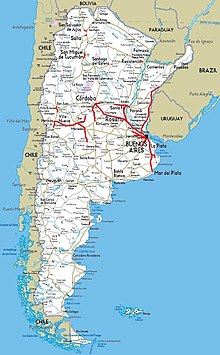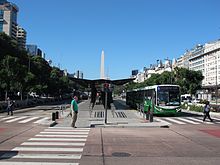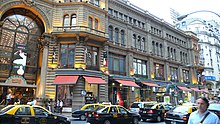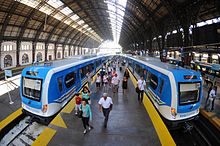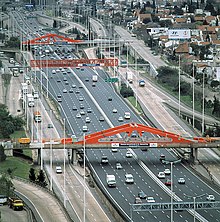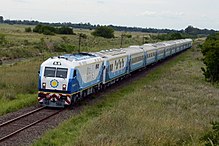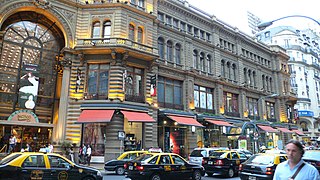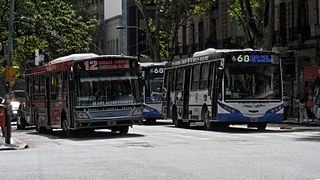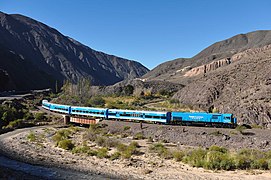
Ferrocarriles Argentinos was a state-owned company that managed the entire Argentine railway system for nearly 45 years. It was formed in 1948 when all the private railway companies were nationalised during Juan Perón's first presidential term, and transformed into the Empresa de Ferrocarriles del Estado Argentino.
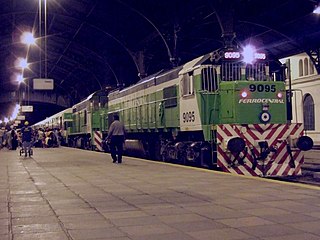
Ferrocentral was an Argentine private railway company, with a name being a portmanteau of the Spanish words for "Central Rail". It operated long-distance passenger trains from its base at Retiro station in Buenos Aires to several locations in northern Argentina, running on Ferrocarril Mitre's 5 ft 6 in Indian gauge tracks.

Tren de la Costa is a suburban 15.5 km (9.6 mi), 11-station light rail line in Greater Buenos Aires, between Maipú Avenue station in the northern suburb of Olivos and Delta station in Tigre, on the Río de la Plata. The line connects with the Mitre line at Maipú station, via a footbridge across Avenida Maipú, for direct access to Retiro terminus in central Buenos Aires.
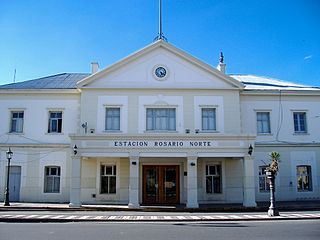
Rosario Norte is a railway station in Rosario, province of Santa Fe, Argentina. It is located on Aristóbulo del Valle Avenue, at the junction with Callao St., north of the city centre, in the neighbourhood known as Barrio Pichincha.
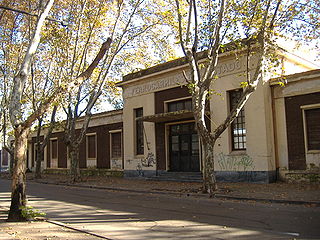
Rosario Oeste is a railway station in Rosario, province of Santa Fe, Argentina. It is located in the west of the city, on the junction of Paraná St. and 9 de Julio streets.

The General Bartolomé Mitre Railway (FCGBM), named after the former Argentine president Bartolomé Mitre, is one of the six state-owned Argentine railway lines formed after President Juan Perón's nationalisation of the railway network in 1948 and one of the largest of Argentina. The six divisions, managed by Ferrocarriles Argentinos were later broken up during the process of railway privatisation beginning in 1991 during Carlos Menem's presidency.

The General Manuel Belgrano Railway (FCGMB), named after the Argentine politician and military leader Manuel Belgrano, is a 1,000 mmmetre gauge railway and the longest of the Argentine system. It was one of the six State-owned Argentine railway companies formed after President Juan Perón's nationalisation of the railway network in 1948.

The General San Martín Railway (FCGSM), named after the former Argentine general José de San Martín, was one of the six state-owned Argentine railway companies formed after President Juan Perón's nationalisation of the railway network in 1948. The six companies were managed by Ferrocarriles Argentinos which was later broken up during the process of railway privatisation beginning in 1991 during Carlos Menem's presidency.
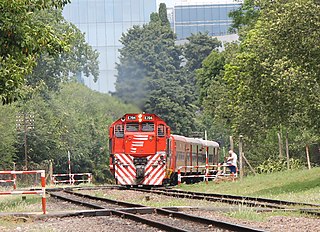
The Belgrano Norte line is a commuter rail service in Buenos Aires, Argentina run by the private company Ferrovías since 1 April 1994. This service had previously been run by the state-owned General Belgrano Railway since nationalisation of the railways in 1948. Ferrovías also formed part of the consortium Unidad de Gestión Operativa Ferroviaria de Emergencia (UGOFE) which operated other commuter rail services in Buenos Aires.

The San Martín line is a 70-kilometre (43 mi), 22-station commuter rail service in the metropolitan area of Buenos Aires, Argentina. The San Martín line operates from the city-centre terminus of Retiro north-west to Doctor Cabred in Luján Partido along a broad gauge line built by the British-owned Buenos Aires and Pacific Railway.

Railway privatisation in Argentina was a process which began in 1989 under the presidency of Carlos Menem, following a series of neoliberal economic reforms. This primarily consisted of breaking up the state-owned railway company Ferrocarriles Argentinos (FA) and allowing the former lines to be operated by private companies instead of the state.
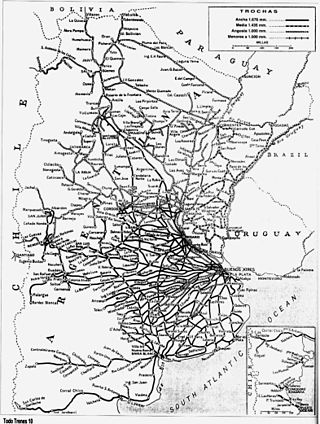
The Argentine railway network consisted of a 47,000 km (29,204 mi) network at the end of the Second World War and was, in its time, one of the most extensive and prosperous in the world. However, with the increase in highway construction, there followed a sharp decline in railway profitability, leading to the break-up in 1993 of Ferrocarriles Argentinos (FA), the state railroad corporation. During the period following privatisation, private and provincial railway companies were created and resurrected some of the major passenger routes that FA once operated.

Operadora Ferroviaria Sociedad del Estado (SOFSE), trading as Trenes Argentinos Operaciones, is an Argentine state-owned company created in 2008 to operate passenger services in Argentina. It operates as a division of Ferrocarriles Argentinos S.E..

Corredores Ferroviarios was an Argentine private company that operated the Mitre and San Martín railway services in Buenos Aires Province for about one year until the Government of Argentina rescinded the agreement with the company in March 2015. Since then, the Mitre and San Martín line are operated by State-owned company Operadora Ferroviaria Sociedad del Estado (SOFSE).
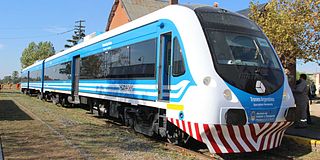
Materfer is an Argentine manufacturer of railway and road vehicles, located in the city of Ferreyra in Córdoba Province. The company was established by Fiat Concord in the late 1950s, being its subsidiary until 1980 when Sevel Argentina took over Fiat vehicles.
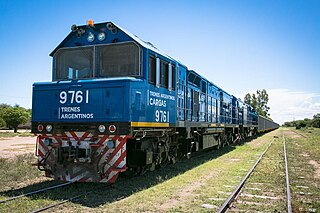
Belgrano Cargas y Logística S.A., trading as Trenes Argentinos Cargas, is an Argentine State-owned company which operates a 15,305 km (9,510 mi) freight rail network that includes Belgrano, Urquiza and San Martín railways. It is a division of Ferrocarriles Argentinos S.E..

Retiro-Mitre, or simply Retiro, is one of the six large mainline railway station termini in Buenos Aires, Argentina. Located in the neighborhood of Retiro, it serves as terminal station for the Mitre Line that runs local trains to the northern suburbs of the Buenos Aires metropolitan area. It also functions as terminal station for the national General Mitre Railway.

Alta Córdoba is a railway station located in the Alta Córdoba neighborhood of Córdoba in the province of the same name, Argentina. The station is terminus of the Tren de las Sierras service operated by state-owned Trenes Argentinos. Likewise, another state company, Trenes Argentinos Cargas y Logística, operates freight services there.

The CSR EMU is a series of electric multiple unit cars manufactured by CSR Corporation Limited for use on Buenos Aires' commuter rail network. As of 2015, the trains operated on three of the city's lines and 705 cars were manufactured, with each line using a different number of cars per train. They were created for use on lines electrified using both third rail and overhead lines.
The Rosario Tramway was a planned mass transit tramway network in Rosario, Argentina. Nevertheless, the project never surpassed the bidding process stages. The project was assessed by Ferrocarrils de la Generalitat Valenciana and was largely inspired by the network the company runs in Valencia, though at one point a metro system was envisioned. The municipal and provincial governments undertaken discussions with the Industrial and Commercial Bank of China for financing the project, as well as Siemens to provide the rolling stock. Once the project was completed, it would be the first time trams have run in the city on a mass scale since the closure of the city's tramway network in 1963, which had reached a maximum extension of 192 km.

